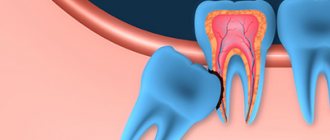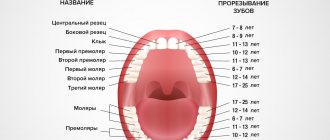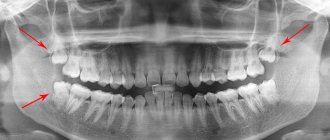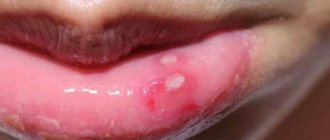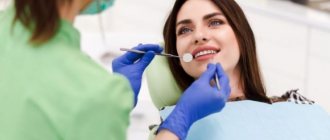In the practice of dentists, there are often cases when a patient’s tooth is fully formed, but does not erupt. It is called “retained”, and the problem is treated with special methods. Teeth that are formed but “stuck” inside the jaw can cause inflammatory processes: pericoronitis, periodontitis, periostitis, abscess, phlegmon, etc. Treatment is carried out using various methods, from removal to wearing specialized braces. Reduce the risk of impacted tooth Prevention helps, for example, wearing trainers that prepare the jaw for the appearance of new teeth.
What is retention? Why does pathology develop? Symptoms and diagnosis
Retention is considered one of the most common teething anomalies. Most often, problems arise with the lower and upper “wisdom teeth”, which grow incorrectly. They are usually encountered by adults. In children, a common impacted tooth is the canine of the upper jaw. The second premolars of the mandible often present unpleasant surprises.
Symptoms of unerupted teeth vary by owner. The problem may not manifest itself at all, or it may cause constant visits to the dentist. The variety of symptoms and their absence is due to the fact that the incorrect position of a tooth or its incomplete eruption is an almost natural phenomenon for humans. Approximately 35-45% of “wisdom eights” in adults are impacted teeth . Difficulties begin to arise when such a molar or premolar causes irritation of the soft tissue around it. Based on indirect signs - pain or inflammation - the doctor identifies the “wrong” tooth.
Semi-retinated teeth are visible immediately at the first examination: they partially grow, but not completely. Such partially erupted molars and premolars cause many more problems: being partially located in the soft tissues, they almost always cause inflammation. There is no need to specifically diagnose them: the doctor almost always finds such teeth during a routine examination.
Finding completely impacted teeth is a real quest. They may not be visible at all, because they are located under the existing elements of the dentition. In this case, there is only one diagnostic option: you need to take a full picture of the jaw, which will clearly show the whole picture. Below in the picture is a selection of examples. Impacted teeth are marked in red or with arrows.
Examples of impacted teeth on x-ray
Is it possible to diagnose retention yourself?
Yes, it is possible, but it is always necessary to additionally consult with a doctor who will decide on the future fate of the retention. Usually around the pathology there are:
- swelling and redness of tissue in the eruption zone;
- pain;
- pulsation;
- the patient feels weak;
- there may be an increase in temperature.
Sometimes retention can occur without symptoms or with muted symptoms, but at an appointment with a dentist, the pathology will be immediately diagnosed.
Unfortunately, the consequences of retention cannot be predicted, but most often cysts and granulomas form on such teeth. There is also a high probability of malocclusion due to the strong pressure of such a tooth on healthy ones.
Types of dental retention
There are many classifications of dental retention. One of the most popular methods of division is by degree of eruption. Thus, there are semi-impacted teeth , which are partially visible in the gum, and completely hidden - located under the gum or bone tissue. The latter are not available for palpation. If the impacted tooth is located in the gum tissue, the diagnosis will say “with tissue immersion,” but if it is located in the bone, “with bone immersion.”
Another classification method takes into account the position of the molar, canine or premolar:
- vertical,
- horizontal,
- corner.
Horizontal teeth can also be transverse, sagittal or oblique, and angular teeth can be mesial, distal, lingual or buccal angular. Rarely, but still there are reverse impacted teeth - these are elements that grow “upside down”, that is, their crown is directed towards the jaw.
Your feedback
I had my wisdom teeth removed at the RUTT clinic.
After six years of torment, during which he constantly made himself known at the most inopportune moments, she finally decided to break up with him. Removal was difficult (or so they said), with sawing and pulling out in parts. In terms of time, the doctor worked for at least 20-30 minutes. But it doesn’t feel like it hurts at all. Apart from picking at the jaw and pressing, I actually felt nothing. Unpleasant - yes, but not painful at all. Victoria |
10/31/2020 Leave a review Other reviews
Causes of impacted teeth. Is it possible to prevent retention?
The most popular reason for impacted teeth is genetic predisposition. Moreover, what is inherited is not the desire of the canines and molars to grow “some into the forest, some for firewood,” but the structure of the jaw. It can be narrow, which is why there is simply not enough space for all the necessary elements of the dentition. But there are other reasons:
- malocclusion, which has formed due to harmful myofunctional habits or mechanical injuries;
- early loss of baby teeth, due to which permanent teeth do not have guidelines for growth;
- “extra” teeth – atavism, called polyodontia;
- initially diseased tooth germs.
In some cases, retention problems can be prevented. Some orthodontists and pediatric dentists recommend the use of trainers to develop the dental arch and give growing canines and molars a guideline for eruption. If the problems are hereditary, only timely treatment will help.
You can read more about trainers in the article: Trainers for straightening teeth: description, varieties, tips for use
And it also happens...
... that wisdom teeth block the neighboring teeth and prevent them from erupting normally. In such cases, patients are referred to a surgeon by an orthodontist.
Of course, the germ of the eighth tooth needs to be removed. This is a fairly simple and relatively comfortable operation.
Look at the pictures on the right. There is a difference of three weeks between the top and bottom. It is clearly visible from them that after removing the rudiments of the eights and “unblocking”, the seventh teeth immediately began to grow.
Wisdom tooth removed. The patient is satisfied. But the fun is yet to come. Namely, the postoperative period.
Why are impacted teeth dangerous?
Despite the fact that sometimes unerupted teeth do not interfere with a person in any way, you need to understand that every impacted tooth is a potential cause of serious and unpleasant diseases. They lead to the following problems:
- inflammatory processes;
- non-healing ulcers on the gums and cheeks;
- constant appearance of caries, pulpitis;
- the appearance of gum pockets, which can cause periodontitis;
- infectious processes, often leading to osteomyelitis (purulent infection of the jaws).
The absence of symptoms is almost always the result of a happy accident, and not a normal development of events. Therefore, with such a diagnosis, it is very important to constantly see a doctor.
Possible complications
When there is an impacted tooth in the oral cavity, dental problems arise over time, which can be used to determine the presence of an impacted tooth:
- the appearance of swelling and soreness of the gums and soft tissues around, aggravated by palpation, an inflammatory process in them;
- redness of the gums, pain reaction in it;
- numbness of the face that occurs due to the pressure of a tightly fitting (not erupted) tooth on the nerve endings;
- pulpitis and caries of neighboring teeth;
- the appearance of an odontogenic cyst;
- resorption (absorption) of the roots of teeth located next to the impacted tooth and constantly compressed by it;
- the onset of inflammation of the periosteum (flux);
- emerging gingivitis, pericoronitis, abscess;
- periostitis, osteomyelitis of the jaw bone and surrounding soft tissue;
- problems with the functional muscles of the face, violation of its aesthetics, difficulty opening the mouth, speech impairment;
- bad breath;
- painful, uncomfortable condition when chewing, inflammation of the mandibular nerve;
- disturbance of taste sensations;
- headaches, trigeminal neuralgia;
- Body temperature may rise and weakness may occur.
Principles of treatment: is it possible to avoid surgery?
Many patients are sure that an impacted dystopic tooth is necessarily a reason for surgical intervention. But dentists try not to cut without a good reason. Therefore, if your extra teeth are not inflamed and do not interfere with your life, it is quite possible to avoid surgery. The doctor may also prescribe the installation of hard metal braces, which will “pull” the partially erupted tooth from the gum tissue and fit it into the dentition.
Typically treatment proceeds as follows:
- A diagnosis is carried out, which includes a visual examination and the creation of a panoramic image of the jaw.
- The doctor examines the results and decides whether the tooth needs to be removed. If yes, then surgery is prescribed.
- If the dentist sees other ways to solve the problem, he prefers them. First of all, the installation of a bracket system is considered. To do this, it is necessary that there is a place in the dentition where a new element could be placed.
- If braces are not required or cannot yet be placed, the doctor will try to help the tooth erupt. For this purpose, medications and surgery are used. Teething assistance is often used when the wisdom tooth is partially left under the gum, but is positioned correctly.
Modern doctors have many treatment methods in their arsenal, but everything completely depends on the specific case.
Stages of treatment for an impacted tooth
Extraction for acute and chronic inflammation
Quite often, the removal of a problematic tooth is accompanied by the presence of purulent foci, gum inflammation or periodontitis. In such cases, the doctor prescribes intensive therapy with the use of antibacterial drugs, and only after the inflammatory process has been suppressed is surgery to remove the tooth performed.
There are also situations when a tooth needs to be removed urgently. Only an experienced, highly qualified doctor can perform surgery in such cases.
When is it necessary to remove an impacted tooth? Why remove impacted teeth?
Even an experienced surgeon will say that removing an impacted dystopic tooth is a serious and complex operation that should not be performed unnecessarily. Therefore, it is indicated in the following cases:
- inflammation of the soft tissues (pericoronitis) or jaw (osteomyelitis);
- the tooth is located in a follicular cyst or grows horizontally;
- a cyst or benign formation is diagnosed;
- pus or bacterial infection is detected.
Removal technique
Removal should be carried out by an experienced doctor who knows the specifics of working with impacted teeth. The main problem here is their inconvenient location, so it’s difficult for a beginner to cope with the problem. Removal takes place in several stages:
- Performing local anesthesia (in case of complex tooth position, general anesthesia can be used).
- An incision in the mucous membrane.
- Drilling into bone tissue to create a hole.
- Tooth extraction.
- Removal of tooth or bone fragments.
- Treatment of the wound.
- Stitching.
- Sutures are removed one week after surgery.
Often, the doctor has to first crush and then remove the tooth so as not to damage the adjacent molars and mucous membrane.
Contraindications
The operation will have to be postponed for the following reasons:
- the patient's serious condition due to any kind of illness;
- hypertensive crisis;
- nervous problems or mental disorders;
- viral infections;
- blood diseases;
- serious heart problems.
For women, this operation is not performed 2-3 days before the start of menstruation and after an abortion (at least 2 weeks must pass).
What complications occur after removal of impacted teeth? How to avoid them
Any operation can cause complications, and surgical treatment of an impacted tooth is no exception. Most often, the consequences manifest themselves as severe bleeding, pain, swelling of the gums or cheeks. If nerves are affected, increased sensitivity or insensitivity of the mouth and face may occur. Due to the incorrect actions of doctors, the patient faces a dislocation of the jaw or even a fracture.
The patient can avoid problems after surgery if he goes to a trusted clinic (excluding the human factor) and carefully takes care of the wound that appears in the mouth. Immediately after surgery, the patient should:
- refuse food for 3-4 hours;
- do not smoke for at least 3 hours;
- Avoid alcohol until the stitches are removed.
It is important to come back for a follow-up appointment with a surgeon or therapist. It is necessary to monitor the bleeding: if it does not stop for too long or painkillers do not work, you should contact the dentist immediately. Timely help will help avoid unpleasant consequences.
Postoperative care after removal of an impacted tooth
The doctor is obliged to advise the patient on how to properly care for the wound on the gum. Since removing an impacted tooth is a full-fledged operation, it is imperative to follow the rules of care. The patient needs:
- reduce physical activity to a minimum for 2-3 days after surgery;
- refuse hot and cold foods and liquids;
- change your toothbrush to a soft one;
- take only a warm shower or bath, do not visit baths and saunas;
- take all medications prescribed by your doctor (antibacterial therapy is usually prescribed).
It is important not to rinse your mouth so as not to disrupt the healing. You can make neat baths (liquid or herbal decoction is taken into the mouth, held without rinsing and spitting), but coordinate all procedures with your doctor.
Make an appointment for lower wisdom tooth removal
Byshlyaga Dmitry Yurievich
Byshlyaga Dmitry Yurievich Orthopedic dentist
Extensive practical experience. Regularly undergoes internships and advanced training courses.
Working hours: from 9.00 to 20.00, daily, seven days a week, by appointment
Make an appointment
More details
Asatryan Alexander Aramovich
Asatryan Alexander Aramovich Dentist therapist - orthopedist - surgeon
Extensive practical experience. Regularly undergoes internships and advanced training courses.
Working hours: from 9.00 to 20.00, daily, seven days a week, by appointment
Make an appointment
More details
×
Conservative methods of treating retention
If the tooth is located correctly in the gum and there is minimal interference with eruption, doctors try not to remove it, but to return it to its intended place by nature. Different methods are used for this:
- laser correction;
- current pulses;
- gum massage;
- electrophoresis;
- some medicines.
All these treatment methods are aimed at making the tooth crown get rid of the gum hood on its own. They partially imitate the natural process of eruption of canines and molars. But the availability of such treatment depends on the situation.
Advantages of treatment at Aurora
Removing the lower wisdom tooth is a complex procedure that requires high specialist competence. Due to the inconvenient location and improper growth of the last molar, neighboring teeth suffer. Highly qualified specialists of our center easily and quickly carry out complex operations of this level. In addition, Aurora dentistry has other important advantages over its competitors:
- the possibility of receiving installments from Pochtabank or Renaissance Credit;
- individual approach;
- work on weekends, including for residents of the region by appointment;
- The doctor is assisted by an assistant, which allows him to carry out manipulations 2 times faster;
- modern, 100% high quality, imported materials.
Our dentistry offers the following promotions for the removal of the lower wisdom tooth:
- If you found out about us through 2GIS, we provide 5% on services;
- 10% discount on your birthday and the next 3 days
- For pensioners there is a “Golden Watch” promotion - a 10% discount on tooth extraction from 9-00 to 11-00
If you need complex and long-term dental treatment in Blagoveshchensk, we have an individual discount policy and a flexible payment schedule
To make an appointment, just call. On the appointed day, the doctor will see the patient and tell him how the lower wisdom tooth will be removed without pain after the procedure and fear.
How to stimulate tooth eruption
Stimulating the eruption of an impacted tooth is also one of the ways to treat the problem. The doctor prescribes specialized procedures if he sees that a molar or canine is positioned correctly, but its roots have not yet formed. Then the orthodontist recommends:
- Carrying out vacuum massage with special equipment;
- light finger massage at the site of eruption;
- electrical stimulation;
- exposure to ultrasound, laser, vibrating vacuum devices, etc.
Such methods are aimed at restoring blood circulation and accelerating metabolic processes in the gums.
Stages of complex tooth extraction
Complex removal surgery is carried out only after x-ray diagnostics, during which the shape, length and depth of the roots are determined. If the patient has inflammation, he is prescribed treatment with antibacterial drugs.
Technique of the procedure
Wisdom tooth removal is carried out in the following order:
- the gum is separated from the neck of the tooth by making an incision in the soft tissue;
- if necessary, the interroot septum is sawed or sections of bone tissue are cut out at the location of the tooth;
- then, using forceps, the tooth is rocked and pulled out of the socket;
- Sutures are placed on the gum.
Painkillers are not required after the procedure, since the effect of the anesthetics is still present.
Conclusions. Expert advice
An impacted tooth is a molar, premolar or incisor that is hidden in bone or gum tissue. If part of the tooth is visible, it is called semi-impacted. Many children and about 40% of adults face this problem when they lose their eights. The appearance of incorrectly positioned teeth itself may go unnoticed – the symptoms are associated with related diseases. Thus, caries in a tooth hidden in the gum almost always causes inflammation of nearby tissues.
It is believed that impacted dystopic teeth are a hereditary problem. But they can appear due to an incorrect bite. Retention can be improved using surgical intervention or conservative methods: massage, electrophoresis, etc. Some dentists recommend wearing trainers, which help develop the dental arch and reduce the risk of improper eruption.
Almost always, the orthodontist tries to return the tooth to the dentition using braces and other methods of influence. If this does not work, the doctor removes the foreign element. The operation is complex, so it is important to contact a specialist. Success largely depends not only on the doctor, but also on the patient: failure to comply with the rules of postoperative care leads to complications.
What to do if you suspect you have a similar problem? See a doctor and be constantly monitored by him. The dentist will prescribe treatment and help prevent complications.
Preparing for dental surgery
If a patient is faced with the removal of a complex tooth, then an experienced doctor will not perform such manipulations without prior preparation. An x-ray is required before the operation. This is necessary to clarify the location of the tooth in the bone, as well as to evaluate the tissues surrounding it.
When a patient has an inflammatory process, it is first cured by taking antibiotics.
Complications after pulling out problem teeth rarely occur, but to avoid them, the procedure should be trusted to a highly qualified doctor.
